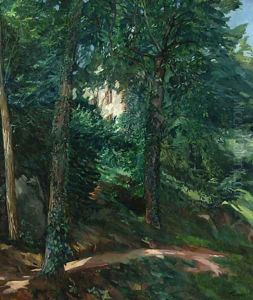Wilhelm Trbner Paintings
Wilhelm Trübner was a German painter associated with the Realist and later Impressionist movements, born on February 3, 1851, in Heidelberg, Germany. His early life was marked by an inclination towards the arts, and he began his formal training at the Karlsruhe Academy of Fine Arts. Initially, Trübner's style was influenced by the academic and conservative art education he received there, but this would change as his career evolved.
In 1867, Trübner moved to the Grand Ducal Academy of Fine Arts in Karlsruhe, where he studied under the history painter Johann Wilhelm Schirmer, who was a proponent of the Düsseldorf school of painting. He later continued his studies under the artist Hans Canon in Vienna. Trübner's early works were characterized by a detailed and realistic approach, influenced by the Old Masters. His dedication to realism and a sober palette was further cemented during his time at the Academy of Fine Arts, Munich, where he became friends with Wilhelm Leibl. Leibl's circle, which Trübner joined, was dedicated to painting directly from life (plein air painting) and adhered to a realist's view that art should represent the truth of everyday life.
In the 1870s, Trübner's style began to shift as he was exposed to the works of Édouard Manet and the French Impressionists, whose looser brushwork and lighter palette deeply influenced him. Trübner's paintings from this period began to reflect these new influences, as he experimented with the effects of light and color while maintaining a commitment to realism. His subjects often included portraits, nudes, and scenes of contemporary life, and he became renowned for his ability to capture the psychological depth of his subjects and the atmospheric conditions of his landscapes and interiors.
Throughout his career, Trübner was involved in various artistic societies and exhibited widely, including at the Munich Secession, which he co-founded. Despite his connection with more modern movements like Impressionism, Trübner remained a contentious figure in the art world, often criticized by conservative circles for his progressive tendencies, while also being too traditional for the avant-garde.
Wilhelm Trübner's contribution to German art was significant, as he bridged the gap between realism and the emerging styles at the turn of the century. His work prefigured the transition to modern art in Germany and influenced younger generations of artists. Trübner continued to paint and exhibit his work until his death on December 21, 1917, in Karlsruhe. His legacy is preserved in the collections of major German museums and galleries, reflecting his status as a key figure in the development of German painting in the late 19th and early 20th centuries.
